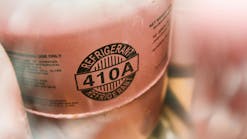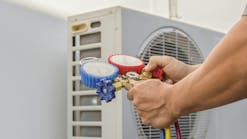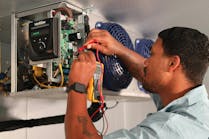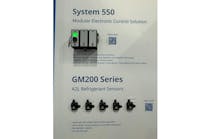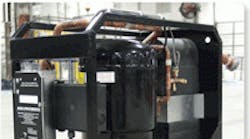Supermarket retailers continue to face significant challenges as they deal with current economic conditions and a regulatory climate that is certain to only get more imposing.
At a recent Food Management Institute (FMI) industry conference, presenters pointed out that if more stringent limits on emissions aren't soon required by regulation, they will eventually be imposed by legislation. Most observers believe that the next round of global climate change talks in Copenhagen later this year will only usher in even stricter requirements.
Add to these market forces further pressures from changing consumer attitudes towards the environment and retailers' impact on it, and the case could be made that there's never been a greater need for sustainable refrigeration technologies.
One new refrigeration technology that has the potential to meet these challenges is the Compact Chiller Module(CCM). This innovative approach to supermarket refrigeration enables stores to reach near-zero sustainable leak rates.
Compact Chiller Module technology takes the concept of secondary (SN) refrigeration (see Refrigeration Service Today: Primary v. Secondary Systems) and leverages it to achieve even greater charge reductions and benefits of sustainability.
CCM systems are comprised of multiple compact chiller modules mounted in a single rack. Together, the modules can handle the medium-temperature requirements of any store. For a larger store, modules are simply added to the rack. Each module is a standalone refrigeration system, completely factory-assembled, charged, and run-tested prior to delivery.
CCMs forgo some of the equipment found on a conventional system such as receivers and oil floats, but each one uses a compressor, a thermal expansion valve, and a unique close-coupled multi-channel heat exchanger. Using this design allows each module to be critically-charged with less than 12 pounds of HFC refrigerant.
Ease of Maintenance
With the individual modules mounted parallel on a rack (a typical system contains from six to eight modules), maintenance is fairly easy. Union collars on ball valves for each of four flexible fluid lines at the back of the module only need to be loosened along with a power and control wires to remove the module. Once the module is out of the rack it can either be worked on, or when necessary replaced by sliding a new module back into the rack and reconnecting the fluid lines, power and control wires.
System Controls and Operation
Along with the multi-channel heat exchanger, each module has a scroll compressor, an electronic or mechanical thermal expansion valve, and a control board. On systems with electronic expansion valves, the onboard controller controls the expansion valve by superheat. The controller has all of the system's safeties, including low and high pressure and also controls the fluid valves for each module.
When a module receives a run signal, the onboard controller opens a fluid valve on the module. The expansion valve then opens to a preset position, on systems with electronic expansion valves, starting the compressor. By modulating the valve through the PID, the controller maintains a specific set superheat.
As with a conventional SN system, chilled fluid from the evaporators is circulated through engineered plastic loop piping to the display cases and walk-in coolers. Heat is removed from the condensers through a warm fluid loop which circulates to a fluid cooler outside the store.
Compact Chiller Module technology provides a relatively simple and straightforward path toward sustainability that cannot be matched by any other type of system. Because of the small amount of refrigerant with which each unit is charged, supermarkets can reduce their HFC charge over 90%. When combined with secondary engineered plastic loop piping systems in the store, the potential to achieve a zero leak rate is feasible. The risk of refrigeration outages is all but eliminated due to the increased dependability of multiple modules since each one typically handles less than 10% of the total load.
Further sustainability benefits may be possible, since small multiple steps of capacity offer potential energy savings and more precise temperature control.
Additional energy savings also come from the system's ability to operate at low condensing temperatures. Significantly lower charge and zero leak-potential positions Compact Chiller Module technology as one of the most effective ways to address the environmental concerns of refrigeration contractors' supermarket customers.
Bill Katz is a technical writer and course developer for the Hill PHOENIX Learning Center. He has written and developed training for the refrigeration and information technology industries. He can be reached at [email protected].
Key Element: Multi-channel Heat Exchanger
The multi-channel heat exchanger is the heart of the system. In this compact vessel, the functions of an evaporator, condenser, and a subcooler are all combined. Whereas a conventional chiller system would use separate heat exchangers for evaporating and condensing, plus a suction line heat exchanger for subcooling, the multi-channel unit combines all those functions into a single device.
As the condensed refrigerant is subcooled, it (the subcooled liquid) actually exits the heat exchanger where it goes through the expansion valve before reentering the vessel through the evaporator portion and chilling the secondary coolant (a mixture of 65% water and 35% propylene glycol). Both condenser fluid and chilled fluid simultaneously move through the vessel; fluid connections on one side and refrigeration connections on the other. Since the system is designed with all the fluid connections on the back, modules are double-stacked and mounted on a frame in parallel to save valuable floor space.
Another unique aspect of the system's design is how it handles oil. An oil siphon tube at the bottom of the evaporator section of the heat exchanger pulls oil collected there back to the compressor with the entering refrigerant. No other oil management devices that are typically needed for a traditional parallel compressor system are required.

